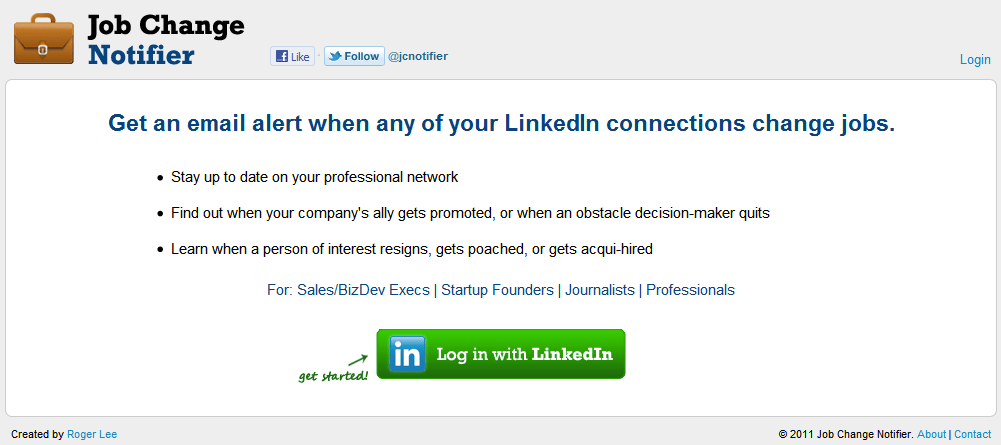Job Change Notifier, a cool little utility that allowed LinkedIn users to track and be notified via email when one of their connections changed jobs, is shutting down due to new restrictions LinkedIn is placing on its API. According to Job Change Notifier creator Roger Lee, the changes impact the ability of “set it and forget it” services like his to function, because now third-party apps can only access user data for 60 days, unless the user re-authenticates with the application.
“We’d have to remind users to log in to the app at least once every 60 days, or else the app would lose access,” Lee explains. “This, of course, makes the service a lot less useful.”
In the two years the service has been up and running, Lee says it had tracked nearly 10 percent of LinkedIn’s user base (22 million connections), had recorded 14 million job changes and sent out 7 million notification emails. Though arguably a small drop in the water that is LinkedIn’s ocean, the service was popular among startups, sales and biz-dev executives and, of course, recruiters.

Fortunately for Lee, a co-founder at ad tech company PaperG, Job Change Notifier was only a side project. (He was once even offered to join LinkedIn, but had declined.)
Though Job Change Notifier is no more, competing services, such as Bullhorn Reach and SalesLoft, are still up-and-running, but only because they offer a web application while Lee’s utility was an email-only service. To keep it functional, Lee would have had to send out emails to users asking them to re-authenticate. It would have been more hassle than it’s worth.
Web Companies’ “Open” APIs Never Seem To Last
The API changes LinkedIn is implementing speak to a larger trend among today’s Internet players – services offer open APIs to third-party developers as they grow, and later start clamping down after achieving significant scale.
We’ve seen this same story play out time and time again, with companies like Facebook and Twitter, and now LinkedIn. Even today, Facebook reacts to threats to its business from competitive services by pulling apps’ ability to access users’ social graph data. For instance, it recently shut off messaging apps’ Path and MessageMe’s “Find Friends” feature, though it still offered the Facebook login and share options.
Meanwhile, Twitter has, for years, readjusted its API as it worked to standardize the Twitter experience for end users. In spring 2011, Twitter informed third-party developers that they should no longer be creating Twitter clients, bringing a busy ecosystem of alternative – and often more feature rich – desktop, web and mobile applications to a stop. That noose was further tightened in 2012. It also shut down access to GeoAPI, which offered a platform for building geo-based apps, and has dabbled with “Find Friends” bans of its own, including most notably, Instagram.
This week, rapidly growing cloud storage startup Dropbox began the same familiar song and dance we’ve seen from web companies over the years – an appeal to the third-party developer community. CEO Drew Houston told reporters the company has no plans to charge developers, after announcing the launch of two new APIs to enable pulling files down from the cloud and syncing. The company already has 100,000 apps on its platform, but wants to grow even further – and it needs developers’ help.
But if history is any indication, developers should be cautious – even if Dropbox plans today to generate revenue through paid subscriptions, there’s no reason why those plans can’t change. Even Houston gave himself an out, saying “it’s conceivable that there would be services in the future where there would be some cost associated with the developer,” then couching that by saying the company doesn’t believe that will ever be a large part of its business model.
But Dropbox’s business itself is still being formed – the company has been acquiring startups that involved themselves with photo sharing and music and email management. What tomorrow’s Dropbox looks like, is still an unknown.
Job Change Notifier’s disappearance from the LinkedIn app ecosystem won’t impact the majority of users; it’s only another example of how the company is further limiting access to its data. And besides, if you really want to know which connections of yours changed jobs, can’t you just read that email LinkedIn is now sending every freaking day?
